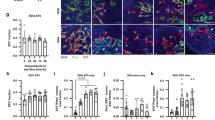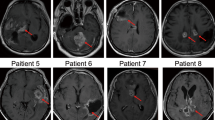Abstract
Temporary reduction in blood-flow within tumour blood vessels can reduce oxygen supply leading to transient perfusion-limited hypoxia. Consequent selection of cells with mutations and reduced radiosensitivity can lead to disease progression and treatment-resistance. In the present study, we investigated whether heterogeneity of labelling after thymidine analogue administration is related to perfusion variations, and if so, could it be quantified and used as a perfusion indicator. Perfusion in murine RIF1 tumours was reduced by hydralazine or increased by nicotinamide and the mice subsequently injected with IdUrd. Tumours were halved for analysis by both flow cytometry and immunohistochemistry. Tumour sections were stained for vasculature and IdUrd. Each blood vessel was scored for the density of IdUrd-labelled cells surrounding it, using a semi-quantitative scoring system. Flow cytometry showed that the IdUrd labelling index and intensity decreased by approximately 50% after hydralazine. In tumour sections of control animals, 2.9% of vessels showed no IdUrd label. In contrast, after hydralazine almost 50% of vessels had no surrounding IdUrd labelling, whereas after nicotinamide there were fewer vessels with low labelling and a higher median score. In conclusion, changes of tumour perfusion by pharmacological agents is reflected in changes in tumour-cell labelling by the thymidine analogue IdUrd, suggesting that IdUrd labelling could be used to indicate perfusion in individual vessels in human tumours. © 2000 Cancer Research Campaign
Similar content being viewed by others
Article PDF
Change history
16 November 2011
This paper was modified 12 months after initial publication to switch to Creative Commons licence terms, as noted at publication
References
Begg AC, Moonen L, Hofland I, Dessing M and Bartelink H (1988) Human tumour cell kinetics using a monoclonal antibody against iododeoxyuridine: intratumour sampling variations (published erratum appears in Radiother Oncol 15: 215). Radiother Oncol 11: 337–347
Begg AC (1995) The clinical status of Tpot as a predictor? Or why no tempest in the Tpot. Int J Radiat Oncol Biol Phys 32: 1539–1541
Begg AC, Haustermans KM, Hart AA, Dische S, Saunders MI, Zackrisson B, Gustafsson H, Coucke P, Paschoud N, Hoyer M, Overgaard J, Antognoni P, Richetti A, Bourhis J, Bartelink H, Horiot JC, Corvo R, Giaretti W, Awwad HK and Shouman T (1999) The value of pretreatment cell kinetic parameters as predictors for radiotherapy outcome in head and neck cancer: a multicenter analysis. Radiother Oncol 50: 13–23
Bernsen HJ, Rijken PF, Oostendorp T and van der Kogel AJ (1995) Vascularity and perfusion of human gliomas xenografted in the athymic nude mouse. Br J Cancer 71: 721–726
Bollinger A (1993) Microlymphatics of human skin. Int J Microcirc Clin Exp 12: 1–15
Brown JM (1979) Evidence for acutely hypoxic cells in mouse tumours and a possible mechanism of reoxygenation. Br J Radiol 52: 650–656
Chaplin DJ, Durand RE and Olive PL (1986) Acute hypoxia in tumours: implications for modifiers of radiation effects. Int J Radiat Oncol Biol Phys 12: 1279–1282
Chaplin DJ, Olive PL and Durand RE (1987) Intermittent blood flow in a murine tumour: radiobiological effects. Cancer Res 47: 597–601
Dewhirst MW (1998) Concepts of oxygen transport at the microcirculatory level. Semin Radiat Oncol 8: 143–150
Durand RE (1983) Oxygen enhancement ratio in V79 spheroids. Radiat Res 96: 322–334
Honess DJ and Bleehen NM (1993) Effects of the radiosensitising agent nicotinamide on relative tissue perfusion and kidney function in C3H mice. Radiother Oncol 27: 140–148
Honess DJ and Bleehen NM (1995) Perfusion changes in the RIF-1 tumour and normal tissues after carbogen and nicotinamide, individually and combined. Br J Cancer 71: 1175–1180
Horsman MR, Chaplin DJ and Brown JM (1987) Radiosensitization by nicotinamide in vivo: a greater enhancement of tumour damage compared to that of normal tissues. Radiat Res 109: 479–489
Huber M, Franzeck UK and Bollinger A (1984) Permeability of superficial lymphatic capillaries in human skin to FITC-labelled dextrans 40 000 and 150 000. Int J Microcirc Clin Exp 3: 59–69
Kimura H, Braun RD, Ong ET, Hsu R, Secomb TW, Papahadjopoulos D, Hong K and Dewhirst MW (1996) Fluctuations in red cell flux in tumour microvessels can lead to transient hypoxia and reoxygenation in tumour parenchyma. Cancer Res 56: 5522–5528
Kotelnikov V, Cass L, Coon JS, Spaulding D and Preisler HD (1997) Accuracy of histone H3 messenger RNA in situ hybridization for the assessment of cell proliferation in human tissues. Clin Cancer Res 3: 669–673
Reinhold HS and van den Berg-Blok A (1983) Vascularization of experimental tumours. Ciba Found Symp 100: 100–119
Spiro IJ, Rice GC, Durand RE, Stickler R and Ling CC (1984) Cell killing, radiosensitization and cell cycle redistribution induced by chronic hypoxia. Int J Radiat Oncol Biol Phys 10: 1275–1280
Sutherland RM and Franko AJ (1980) On the nature of the radiobiologically hypoxic fraction in tumours. Int J Radiat Oncol Biol Phys 6: 117–120
Thomlinson RH and Gray LH (1955) The histological structure of some human lung cancers as the possible implications for radiotherapy. Brit J Cancer 9: 539
Trotter MJ, Acker BD and Chaplin DJ 1989 a) Histological evidence for nonperfused vasculature in a murine tumour following hydralazine administration. Int J Radiat Oncol Biol Phys 17: 785–789
Trotter MJ, Chaplin DJ, Durand RE and Olive PL 1989 b) The use of fluorescent probes to identify regions of transient perfusion in murine tumours. Int J Radiat Oncol Biol Phys 16: 931–934
Twentyman PR, Brown JM, Gray JW, Franko AJ, Scoles MA and Kallman RF (1980) A new mouse tumour model system (RIF-1) for comparison of end-point studies. J Natl Cancer Inst 64: 595–604
van Geel IP, Oppelaar H, Rijken PF, Bernsen HJ, Hagemeier NE, van der Kogel AJ, Hodgkiss RJ and Stewart FA (1996) Vascular perfusion and hypoxic areas in RIF-1 tumours after photodynamic therapy. Br J Cancer 73: 288–293
Author information
Authors and Affiliations
Rights and permissions
From twelve months after its original publication, this work is licensed under the Creative Commons Attribution-NonCommercial-Share Alike 3.0 Unported License. To view a copy of this license, visit http://creativecommons.org/licenses/by-nc-sa/3.0/
About this article
Cite this article
Begg, A., Hofland, I., Van Der Pavert, I. et al. Use of thymidine analogues to indicate vascular perfusion in tumours. Br J Cancer 83, 899–905 (2000). https://doi.org/10.1054/bjoc.2000.1372
Received:
Revised:
Accepted:
Published:
Issue date:
DOI: https://doi.org/10.1054/bjoc.2000.1372



